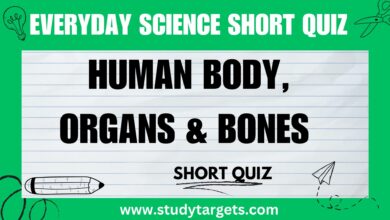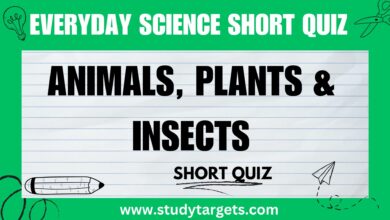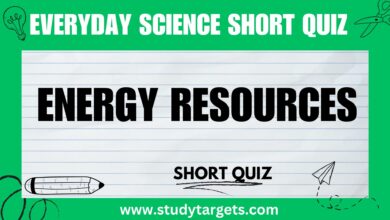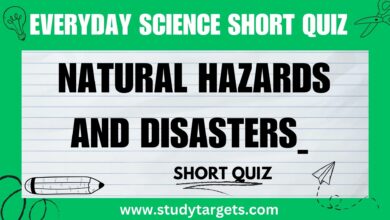MCQs: Human Body ,Organs ,Bones: Everyday Science MCQs
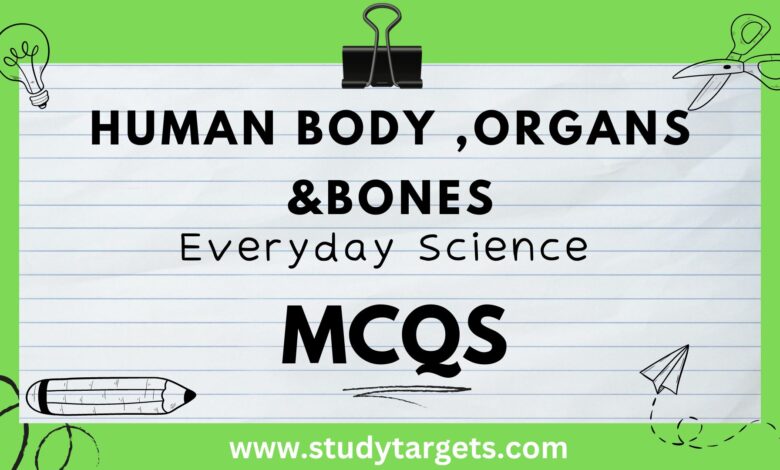
Human Body & Organs
1.What is the largest organ in the human body?
a) Liver
b) Brain
c) Heart
d) Skin
Answer: d) Skin
2. What is the primary function of the respiratory system?
a) Pump blood throughout the body
b) Digest food
c) Exchange gases (oxygen and carbon dioxide)
d) Produce hormones
Answer: c) Exchange gases (oxygen and carbon dioxide)
3. Which part of the human brain is responsible for voluntary muscle movements and coordination?
a) Cerebellum
b) Cerebrum
c) Medulla oblongata
d) Thalamus
Answer: a) Cerebellum
4. What is the purpose of the circulatory system?
a) Regulate body temperature
b) Break down food for energy
c) Transport nutrients, oxygen, and waste products throughout the body
d) Produce hormones for growth
Answer: c) Transport nutrients, oxygen, and waste products throughout the body
5. Which of the following bones protects the brain?
a) Femur
b) Skull
c) Ribs
d) Spine (vertebrae)
Answer: b) Skull
6. What is the role of the kidneys in the human body?
a) Regulate blood sugar levels
b) Produce bile for digestion
c) Filter waste products from the blood and produce urine
d) Control heart rate
Answer: c) Filter waste products from the blood and produce urine
7. Which part of the human eye is responsible for adjusting the amount of light that enters the eye?
a) Pupil
b) Cornea
c) Lens
d) Retina
Answer: c) Lens
8. What is the purpose of the digestive system?
a) Regulate body temperature
b) Exchange gases (oxygen and carbon dioxide)
c) Break down food for absorption of nutrients
d) Pump blood throughout the body
Answer: c) Break down food for absorption of nutrients
9. Which of the following is NOT a primary taste sensed by the human tongue?
a) Sweet
b) Sour
c) Spicy
d) Bitter
Answer: c) Spicy
10. What is the purpose of the endocrine system in the human body?
a) Regulate body temperature
b) Control voluntary muscle movements
c) Produce hormones that regulate various bodily functions
d) Transport nutrients and gases throughout the body
Answer: c) Produce hormones that regulate various bodily functions
11. Which part of the human heart is responsible for pumping oxygenated blood to the body?
a) Left atrium
b) Right atrium
c) Left ventricle
d) Right ventricle
Answer: c) Left ventricle
12. Which of the following is NOT a component of the human skeletal system?
a) Skull
b) Ribcage
c) Pancreas
d) Pelvis
Answer: c) Pancreas
13. What is the purpose of the lymphatic system in the human body?
a) Produce insulin for blood sugar regulation
b) Transport oxygen and carbon dioxide
c) Fight infections and remove excess fluid from tissues
d) Digest food and absorb nutrients
Answer: c) Fight infections and remove excess fluid from tissues
14. Which part of the human brain is responsible for controlling basic life functions such as breathing and heart rate?
a) Cerebellum
b) Cerebrum
c) Medulla oblongata
d) Thalamus
Answer: c) Medulla oblongata
15. What is the purpose of the integumentary system?
a) Exchange gases (oxygen and carbon dioxide)
b) Regulate body temperature
c) Control voluntary muscle movements
d) Transport nutrients and waste products throughout the body
Answer: b) Regulate body temperature
16. Which of the following is NOT a component of the human nervous system?
a) Brain
b) Spinal cord
c) Nerves
d) Liver
Answer: d) Liver
17. What is the purpose of the immune system in the human body?
a) Regulate blood sugar levels
b) Produce bile for digestion
c) Fight off infections and foreign invaders
d) Control heart rate
Answer: c) Fight off infections and foreign invaders
18. Which of the following is the primary male reproductive organ?
a) Testes
b) Prostate gland
c) Penis
d) Epididymis
Answer: a) Testes
19. Which of the following organs is responsible for filtering waste products from the blood and producing urine?
a) Liver
b) Kidneys
c) Lungs
d) Stomach
Answer: b) Kidneys
20. What is the body’s largest internal organ?
a) Heart
b) Liver
c) Brain
d) Lungs
Answer: b) Liver
21. What is the approximate number of bones in the adult human body?
a) 100
b) 206
c) 300
d) 500
Answer: b) 206
22. What is the primary function of the red blood cells in the human body?
a) Fighting infections
b) Transporting oxygen
c) Digesting food
d) Regulating body temperature
Answer: b) Transporting oxygen
23. Which part of the human brain is responsible for regulating vital functions such as breathing and heart rate?
a) Cerebellum
b) Cerebrum
c) Medulla oblongata
d) Thalamus
Answer: c) Medulla oblongata
24. What is the main function of the respiratory system?
a) Pumping blood throughout the body
b) Breaking down food for energy
c) Exchanging gases (oxygen and carbon dioxide)
d) Producing hormones
Answer: c) Exchanging gases (oxygen and carbon dioxide)
25. How many chambers are there in the human heart?
a) 2
b) 3
c) 4
d) 5
Answer: c) 4
26. What is the function of the small intestine in the digestive system?
a) Absorbing nutrients from food
b) Breaking down food into smaller particles
c) Storing waste before elimination
d) Producing enzymes for digestion
Answer: a) Absorbing nutrients from food
27. Which of the following is NOT a primary taste sensed by the human tongue?
a) Sweet
b) Sour
c) Spicy
d) Bitter
Answer: c) Spicy
28. What is the purpose of the immune system in the human body?
a) Regulating blood sugar levels
b) Producing bile for digestion
c) Fighting off infections and foreign invaders
d) Controlling heart rate
Answer: c) Fighting off infections and foreign invaders
29. Which organ is responsible for filtering waste products from the blood and producing urine?
a) Liver
b) Kidneys
c) Lungs
d) Stomach
Answer: b) Kidneys
30. What is the largest internal organ in the human body?
a) Heart
b) Liver
c) Brain
d) Lungs
Answer: b) Liver
31. What is the primary function of the respiratory system?
a) Pumping blood throughout the body
b) Digesting food
c) Exchanging gases (oxygen and carbon dioxide)
d) Producing hormones
Answer: c) Exchanging gases (oxygen and carbon dioxide)
32. Which of the following organs is commonly referred to as the “voice box” and is responsible for producing sound?
a) Larynx
b) Thyroid gland
c) Pancreas
d) Gallbladder
Answer: a) Larynx
33. What is the function of the pancreas in the human body?
a) Regulating blood sugar levels
b) Producing bile for digestion
c) Filtering waste products from the blood
d) Controlling heart rate
Answer: a) Regulating blood sugar levels
34. Which organ is responsible for producing insulin and glucagon to regulate blood sugar levels?
a) Liver
b) Pancreas
c) Kidneys
d) Thyroid gland
Answer: b) Pancreas
35. What is the primary function of the digestive system?
a) Regulating body temperature
b) Exchanging gases (oxygen and carbon dioxide)
c) Breaking down food for absorption of nutrients
d) Pumping blood throughout the body
Answer: c) Breaking down food for absorption of nutrients
36. Which organ is responsible for storing and concentrating bile produced by the liver?
a) Larynx
b) Thyroid gland
c) Pancreas
d) Gallbladder
Answer: d) Gallbladder
37. What is the main function of the endocrine system in the human body?
a) Regulating body temperature
b) Controlling voluntary muscle movements
c) Producing hormones that regulate various bodily functions
d) Exchanging gases (oxygen and carbon dioxide)
Answer: c) Producing hormones that regulate various bodily functions
38. Which of the following is NOT a part of the central nervous system (CNS)?
a) Brain
b) Spinal cord
c) Peripheral nerves
d) Answer: c) Peripheral nerves
39.What is the primary function of the liver in the human body?
a) Producing insulin to regulate blood sugar levels
b) Filtering waste products from the blood
c) Breaking down food for absorption of nutrients
d) Detoxifying harmful substances and producing bile
Answer: d) Detoxifying harmful substances and producing bile
40. Which of the following organs is responsible for producing red blood cells, white blood cells, and platelets?
a) Liver
b) Spleen
c) Kidneys
d) Bone marrow
Answer: d) Bone marrow
41. What is the function of the gallbladder in the human body?
a) Producing bile for digestion
b) Regulating blood sugar levels
c) Filtering waste products from the blood
d) Pumping blood throughout the body
Answer: a) Producing bile for digestion
42. Which organ is responsible for regulating metabolism and producing hormones like thyroxine?
a) Liver
b) Pancreas
c) Thyroid gland
d) Gallbladder
Answer: c) Thyroid gland
43. What is the primary function of the spleen in the human body?
a) Regulating body temperature
b) Filtering waste products from the blood
c) Producing insulin to regulate blood sugar levels
d) Aiding in the immune response and removing damaged blood cells
Answer: d) Aiding in the immune response and removing damaged blood cells
44. Which organ is responsible for producing digestive enzymes and bicarbonate to neutralize stomach acid?
a) Liver
b) Kidneys
c) Pancreas
d) Spleen
Answer: c) Pancreas
45. What is the function of the adrenal glands in the human body?
a) Regulating blood sugar levels
b) Producing bile for digestion
c) Producing hormones like adrenaline and cortisol for stress response
d) Filtering waste products from the blood
Answer: c) Producing hormones like adrenaline and cortisol for stress response
46. Which organ is responsible for storing and releasing urine?
a) Liver
b) Spleen
c) Kidneys
d) Bladder
Answer: d) Bladder
47. What is the main function of the lymph nodes in the human body?
a) Producing red blood cells
b) Regulating metabolism
c) Filtering and trapping harmful substances from the lymph fluid
d) Producing insulin to regulate blood sugar levels
Answer: c) Filtering and trapping harmful substances from the lymph fluid
48. Which of the following organs is NOT a part of the human digestive system?
a) Stomach
b) Liver
c) Pancreas
d) Thyroid gland
Answer: d) Thyroid gland
Human Heart:
1. Which of the following is the primary function of the human heart?
a) Pumping blood throughout the body
b) Digesting food
c) Producing hormones
d) Exchanging gases (oxygen and carbon dioxide)
Answer: a) Pumping blood throughout the body
2. How many chambers are there in the human heart?
a) 2
b) 3
c) 4
d) 5
Answer: c) 4
3. What is the name of the valve that separates the left ventricle from the aorta?
a) Tricuspid valve
b) Mitral valve
c) Pulmonary valve
d) Aortic valve
Answer: d) Aortic valve
4. Which blood vessels supply oxygenated blood to the heart muscle itself?
a) Pulmonary arteries
b) Pulmonary veins
c) Coronary arteries
d) Coronary veins
Answer: c) Coronary arteries
5. What is the largest artery in the human body?
a) Carotid artery
b) Pulmonary artery
c) Coronary artery
d) Aorta
Answer: d) Aorta
6. What is the function of the mitral valve in the human heart?
a) Prevent backflow of blood from the left ventricle to the left atrium
b) Prevent backflow of blood from the right ventricle to the right atrium
c) Control blood flow to the lungs
d) Control blood flow to the body
Answer: a) Prevent backflow of blood from the left ventricle to the left atrium
7. Which chamber of the heart receives oxygenated blood from the lungs?
a) Left atrium
b) Right atrium
c) Left ventricle
d) Right ventricle
Answer: a) Left atrium
8. What is the name of the “pacemaker” of the heart that regulates the heartbeat?
a) Aorta
b) Sinoatrial node (SA node)
c) Atrioventricular node (AV node)
d) Vena cava
Answer: b) Sinoatrial node (SA node)
9. When the heart contracts and pumps blood, it is referred to as:
a) Diastole
b) Systole
c) Tachycardia
d) Bradycardia
Answer: b) Systole
10. Which blood vessels carry deoxygenated blood from the body back to the heart?
a) Arteries
b) Veins
c) Capillaries
d) Aorta
Answer: b) Veins
Human Brain:
1. What is the main function of the human brain?
a) Pumping blood throughout the body
b) Digesting food
c) Regulating body temperature
d) Controlling thoughts, emotions, and body functions
Answer: d) Controlling thoughts, emotions, and body functions
2. Which part of the brain is responsible for balance and coordination?
a) Cerebellum
b) Cerebrum
c) Medulla oblongata
d) Thalamus
Answer: a) Cerebellum
3. What is the largest part of the human brain responsible for conscious thought, memory, and voluntary movements?
a) Cerebellum
b) Cerebrum
c) Medulla oblongata
d) Thalamus
Answer: b) Cerebrum
4. Which lobe of the brain is associated with processing visual information?
a) Frontal lobe
b) Parietal lobe
c) Occipital lobe
d) Temporal lobe
Answer: c) Occipital lobe
5. What is the function of the frontal lobe in the human brain?
a) Processing auditory information
b) Controlling voluntary muscle movements
c) Processing sensory information
d) Regulating heart rate and breathing
Answer: b) Controlling voluntary muscle movements
6. Which part of the brain is often referred to as the “emotional center” and is involved in memory and learning?
a) Cerebellum
b) Cerebrum
c) Amygdala
d) Hypothalamus
Answer: c) Amygdala
7. What is the primary function of the parietal lobe in the human brain?
a) Processing visual information
b) Controlling voluntary muscle movements
c) Processing sensory information like touch and taste
d) Regulating body temperature
Answer: c) Processing sensory information like touch and taste
8. The temporal lobe in the brain is responsible for:
a) Controlling balance and coordination
b) Processing auditory information and language comprehension
c) Regulating heart rate and breathing
d) Processing visual information
Answer: b) Processing auditory information and language comprehension
9. Which part of the brain is responsible for regulating vital functions such as heart rate, breathing, and blood pressure?
a) Cerebellum
b) Cerebrum
c) Medulla oblongata
d) Thalamus
Answer: c) Medulla oblongata
10. The hypothalamus plays a crucial role in:
a) Regulating body temperature and hunger
b) Processing visual information
c) Controlling voluntary muscle movements
d) Processing auditory information
Answer: a) Regulating body temperature and hunger
Human Eyes:
1. Which part of the eye is responsible for controlling the amount of light that enters?
a) Cornea
b) Pupil
c) Retina
d) Iris
Answer: d) Iris
2. What is the transparent, outermost layer of the eye that protects it and helps focus light?
a) Cornea
b) Lens
c) Retina
d) Sclera
Answer: a) Cornea
3. The colored part of the eye that surrounds the pupil is called the:
a) Cornea
b) Pupil
c) Retina
d) Iris
Answer: d) Iris
4. Which part of the eye contains photoreceptor cells that convert light into electrical signals sent to the brain?
a) Cornea
b) Pupil
c) Retina
d) Iris
Answer: c) Retina
5. What is the purpose of the lens in the human eye?
a) Controlling the size of the pupil
b) Producing tears to keep the eye moist
c) Focusing light onto the retina
d) Regulating eye color
Answer: c) Focusing light onto the retina
6. Which of the following statements is true about the fovea in the human eye?
a) It is responsible for peripheral vision.
b) It is the blind spot of the eye.
c) It is the part of the retina with the highest concentration of photoreceptor cells.
d) It is another term for the cornea.
Answer: c) It is the part of the retina with the highest concentration of photoreceptor cells.
7. What is the function of the optic nerve?
a) To control the size of the pupil
b) To transmit visual information from the eye to the brain
c) To produce tears for lubrication
d) To regulate eye color
Answer: b) To transmit visual information from the eye to the brain
8. Which part of the eye is commonly known as the “white of the eye”?
a) Cornea
b) Pupil
c) Retina
d) Sclera
Answer: d) Sclera
9. What part of the eye is responsible for producing tears?
a) Cornea
b) Pupil
c) Lacrimal gland
d) Iris
Answer: c) Lacrimal gland
10. What is the function of the ciliary muscles in the human eye?
a) To produce tears for lubrication
b) To control the size of the pupil
c) To focus the lens for near and far vision
d) To transmit visual information to the brain
Answer: c) To focus the lens for near and far vision
Human Bones:
1.How many bones are in the adult human body?
a) 106
b) 206
c) 306
d) 406
Answer: b) 206
2. Which of the following is the longest bone in the human body?
a) Femur
b) Humerus
c) Tibia
d) Radius
Answer: a) Femur
3. What is the function of the skeletal system in the human body?
a) Pumping blood
b) Digesting food
c) Providing support and structure
d) Exchanging gases
Answer: c) Providing support and structure
4. Which bones protect the brain from injury?
a) Ribs
b) Pelvis
c) Skull
d) Sternum
Answer: c) Skull
5. What type of bone is the patella (kneecap)?
a) Long bone
b) Flat bone
c) Irregular bone
d) Short bone
Answer: d) Short bone
6. Where are red blood cells primarily produced in the human body?
a) Liver
b) Spleen
c) Kidneys
d) Bone marrow
Answer: d) Bone marrow
7. Which bones make up the forearm in the human body?
a) Ulna and radius
b) Femur and tibia
c) Scapula and clavicle
d) Tibia and fibula
Answer: a) Ulna and radius
8. Which bone is commonly referred to as the “collarbone”?
a) Humerus
b) Clavicle
c) Scapula
d) Sternum
Answer: b) Clavicle
9. What is the function of the ribcage in the human body?
a) Protecting the heart and lungs
b) Supporting the weight of the body
c) Aiding in digestion
d) Producing red blood cells
Answer: a) Protecting the heart and lungs
10. Which of the following is NOT a type of bone in the human body?
a) Long bone
b) Flat bone
c) Circular bone
d) Irregular bone
Answer: c) Circular bone

